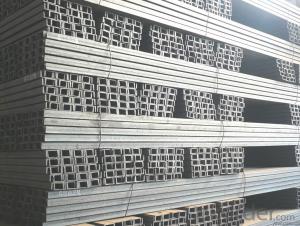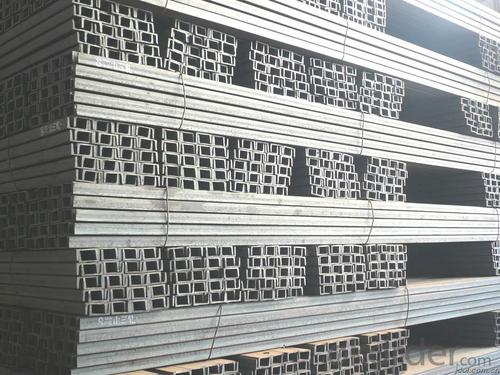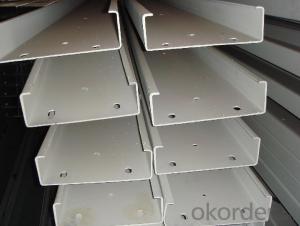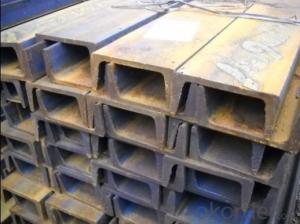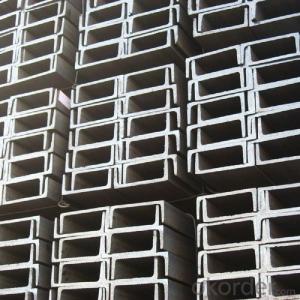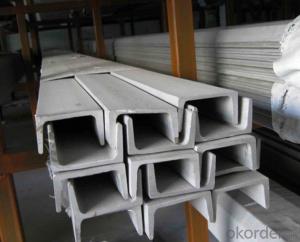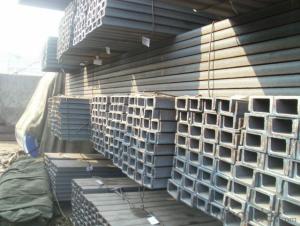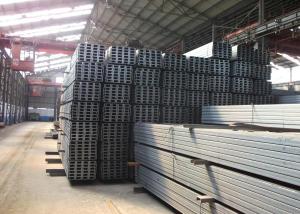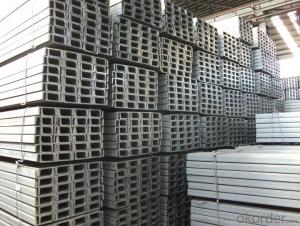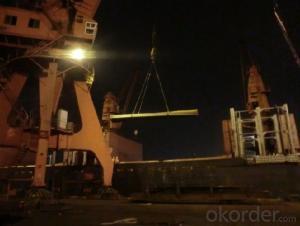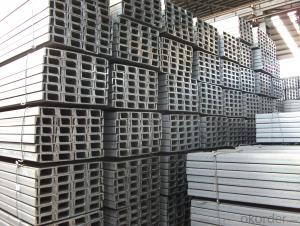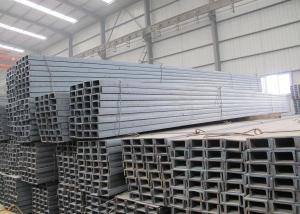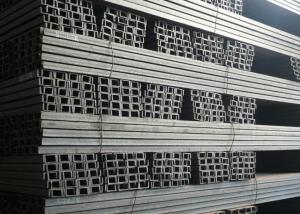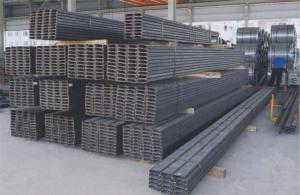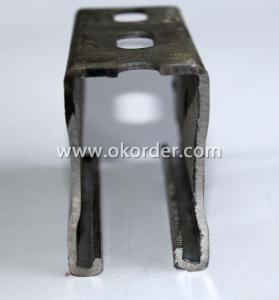Steel U Channel With High Tensile Strength
- Loading Port:
- China main port
- Payment Terms:
- TT or LC
- Min Order Qty:
- 50 m.t.
- Supply Capability:
- 50000 m.t./month
OKorder Service Pledge
OKorder Financial Service
You Might Also Like
Description
In the production of steel products, steel is molded and reshaped with different machinery at different temperatures. One process is steel rolling, which involves metal stock passing through a pair of rolls. Rolling produces flat steel sheets of a specific thickness, and the process is classified according to the temperature at which the metal is rolled. If the temperature of the metal is above its recrystallization temperature, or the temperature at which the grain structure of the metal can be altered, then the process is termed as hot rolling. If the temperature of the metal is below its recrystallization temperature, the process is termed as cold rolling.
Like cold rolling, cold drawing is performed at room temperature, but instead of producing a flat object like a coke can, cold drawing makes steel into the form of a wire like the spokes of a wheel or a paper clip. To start the process, Steel is usual hammered and rolled so that it can be fit through a die; a tool that turns the steel mass into a wire. The room temperature steel is pulled through the die which reshapes it into a thinner shape while maintaining the same volume. It is similar to the idea of syrup flowing out of a bottle through a tube in that it changes shape but not volume, but instead of squeezing the metal, it is pulled out. In order to get the wire down to the right diameter, it usually requires more than one pass through different dies.
Chemical Compostion
Grade | Element(%) | |||
C | Mn | P | S | |
SS330 | -- | -- | ≦0.050 | ≦0.050 |
SS400 | ||||
SS490 | ||||
SS540 | ≦0.30 | ≦1.60 | ≦0.040 | ≦0.040 |
Usage/Applications
Channel Steel is usually used for building structure, vehicle manufacturing and other industrial structure and often used with i beam.
In details, the channel steel belongs to carbon structural steel which is applied to in the field of construction and machinery. The channel steel is usually used for arch-itechtural structure, and they could be welded in order to support or hang a vari-ety of facilities. They are also usually used in combination with I beam. Generally,the channel steel must possess perfect welding property, riveting property and mechanical property and so on.
FAQ:
Q1: Why buy Materials & Equipment from OKorder.com?
A1: All products offered byOKorder.com are carefully selected from China's most reliable manufacturing enterprises. Through its ISO certifications, OKorder.com adheres to the highest standards and a commitment to supply chain safety and customer satisfaction.
Q2: How do we guarantee the quality of our products?
A2: We have established an advanced quality management system which conducts strict quality tests at every step, from raw materials to the final product. At the same time, we provide extensive follow-up service assurances as required.
Q4: What makes stainless steel stainless?
A4: Stainless steel must contain at least 10.5 % chromium. It is this element that reacts with the oxygen in the air to form a complex chrome-oxide surface layer that is invisible but strong enough to prevent further oxygen from "staining" (rusting) the surface. Higher levels of chromium and the addition of other alloying elements such as nickel and molybdenum enhance this surface layer and improve the corrosion resistance of the stainless material.
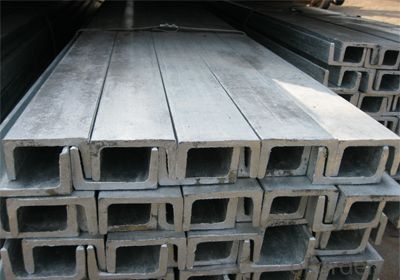
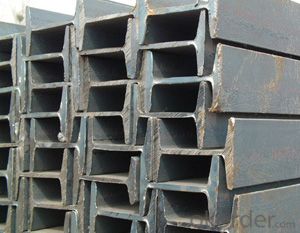
- Q: Can steel channels be used for suspended ceilings?
- Yes, steel channels can be used for suspended ceilings. They provide structural support and can be easily installed to create a sturdy framework for the suspended ceiling tiles.
- Q: Where can I find the tensile strength of channel steel?
- No, it depends on what you use in that area. Many of them can be divided into tensile strength, yield strength and specific termsThe concrete formula does not seem to be available. Only by experiment can we get the exact number
- Q: What are the factors to consider when selecting the appropriate steel grade for a channel?
- When selecting the appropriate steel grade for a channel, there are several factors to consider. These include the load and weight requirements of the channel, the environmental conditions it will be exposed to (such as humidity or corrosion), the desired level of strength and durability, and the cost constraints of the project. Additionally, factors like the channel's intended application, fabrication requirements, and any specific standards or regulations that need to be met should also be taken into account. Overall, the selection of the steel grade should align with the specific needs and specifications of the channel to ensure optimal performance and longevity.
- Q: Is the track steel often called channel or construction steel?
- Rectangular steel can be used as upright post. The crossbeam and so on, characteristic is starts the thing quickly. (it is faster to weld than two to channel steel)If the bridge, house, girder, anyway, from the top down is pressed by I-beam, the most rational rail steel and general construction steel different, but I type strong forceRail steel is a high strength alloy steel. The requirements are strict and the properties are different
- Q: What are the deflection limits for steel channels?
- The deflection limits for steel channels vary depending on several factors such as the size, shape, and material properties of the channel. However, as a general guideline, the deflection limits for steel channels typically range between L/360 to L/240, where L is the length of the channel. These limits ensure that the channel remains structurally stable and prevents excessive bending or sagging under its intended load. It is important to consult design codes and engineering standards for specific deflection limits based on the application and design requirements.
- Q: What are the different cross-sectional shapes available for steel channels?
- The different cross-sectional shapes available for steel channels include C-shape, U-shape, and Z-shape.
- Q: Are steel channels suitable for the mining industry?
- Yes, steel channels are suitable for the mining industry. They are known for their strength, durability, and versatility, making them ideal for various mining applications such as support structures, conveyor systems, and equipment frames. Steel channels can withstand heavy loads and harsh environments commonly found in mines, ensuring reliable performance and long-term durability.
- Q: What are the different types of steel channel profiles?
- There are several different types of steel channel profiles, each designed for specific applications and structural needs. Some of the commonly used types include: 1. C Channel: This is a popular type of steel channel profile that has a C-shaped cross-section. It is often used in construction and engineering projects as a structural support or as a frame for various applications. 2. U Channel: Also known as a U-shaped channel, this type has a similar cross-section to the letter "U". It is commonly used in construction, manufacturing, and automotive industries for applications such as framing, bracing, and support. 3. Hat Channel: Hat channels have a distinctive hat-like shape, with a flat bottom and two vertical sides. They are often used in construction for applications such as ceiling and wall framing, as well as in the automotive industry for reinforcing structural components. 4. Box Channel: As the name suggests, box channels have a rectangular or square cross-section. They are frequently used in construction, manufacturing, and engineering projects where strength and rigidity are required. 5. Z Channel: Z channels have a Z-shaped cross-section, with two flanges on opposite sides and a center web connecting them. They are commonly used in construction for applications such as framing, support, and bracing, especially in roofing and cladding systems. 6. Lipped Channel: Lipped channels, also known as lip channels or lip sections, have an additional lip or flange along one side of the channel. This lip provides extra strength and rigidity, making it suitable for applications such as shelving, racking, and structural support. These are just a few examples of the different types of steel channel profiles available. The choice of profile depends on the specific requirements of the project, including load-bearing capacity, structural stability, and overall design considerations.
- Q: Can steel channels be used in the construction of automotive frames?
- Yes, steel channels can be used in the construction of automotive frames. Steel channels provide strength, durability, and rigidity required for supporting and protecting the vehicle's structure.
- Q: Are steel channels available in pre-fabricated lengths?
- Yes, steel channels are available in pre-fabricated lengths. Steel channels are commonly used in construction and engineering projects, and they can be manufactured in various lengths to suit different applications. These pre-fabricated lengths make it easier for builders and contractors to work with the steel channels, as they can be easily transported and installed on-site. Additionally, pre-fabricated lengths help to ensure consistency in dimensions and quality, as they are produced in controlled environments using specialized equipment.
Send your message to us
Steel U Channel With High Tensile Strength
- Loading Port:
- China main port
- Payment Terms:
- TT or LC
- Min Order Qty:
- 50 m.t.
- Supply Capability:
- 50000 m.t./month
OKorder Service Pledge
OKorder Financial Service
Similar products
Hot products
Hot Searches
Related keywords
